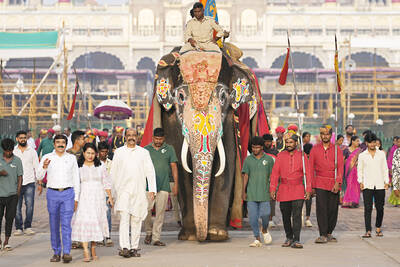Hidden about 10m below Jieyun Road (捷運路) in Sanchong, a Puerto Rican design company recently spent 45 days infusing a drab Taipei County intersection with “really hardcore” Mexican reds, “super intense” Mexican yellows and festive Brazilian oranges.
When I visited the MRT Sanchong Station (三重捷運站) worksite in late April, Alvaro Racines greeted me with a smile, a handshake and a hardhat. We descended a flight of stairs into the cluttered cavern that now houses one of the Department of Rapid Transit Systems’ (DORTS) largest art projects to date: a 60m-long, 3m-high mosaic called Echoes of Ages.
Cero Design, a portmanteau of the first names of co-founders Celso Gonzalez and Roberto Biaggi, had finished almost half of the piece’s abstract background and was painstakingly working on a dragon that is the work’s centerpiece. When construction of the station is complete, the mosaic will span one wall of a large lobby between two entrances.
The soft-spoken Racines handed me off to Biaggi for a tour and climbed a scaffold to resume working. Pounding hammers, buzzing electric saws and whirring overhead traffic intermittently drowned out a Bob Marley album playing from a cheap portable stereo. Biaggi’s booming voice came in handy.
At quieter moments, the continuous clicking of Cero’s seven-man team using pliers to break tiles drove home the scale of the piece. The average tiles were originally 10cm squares, but the team broke them into much smaller, more interesting shapes.
Biaggi, Gonzalez and “the crew” mixed mortar in pickle buckets, smeared it on the wall with trowels and pressed in broken pieces of tile — sometimes so small they could fit in a bottlecap. Earlier they had drawn a grid over the entire concrete surface and sketched or spray-painted lines on the wall, using a level to be sure the image matched their draft.
The installation process may sound simple, but Cero has developed labor-intensive techniques that make their works distinctive. For example, when tiles define a line between two fields of color Biaggi called “pools,” Cero always uses the unbroken, beveled outside of a tile to highlight the division between the two areas.
“Other people use the rough [broken] side, even for edges,” Biaggi said. “It looks kind of ... I wouldn’t say crappy, but less meticulous.”
Even within these “pools” they were careful to combine different tiles to add depth to what might otherwise be a plain swatch of color. White areas often contain light grays; orange areas blend glossy and matte yellows, oranges and reds. Most of the hundreds of “pools” diffuse one color into another: In one place lighter blends to darker from left to right, and in another area a red outline diffuses into yellow in its center.
Cero takes color very seriously. “It’s our thing,” Biaggi says. The team visited about 10 tile-making factories in Taiwan, mostly in Yingge Township (鶯歌), the country’s ceramics capital. While they were impressed with the durability of Taiwanese tiles and were excited to find an “excellent” gold, Biaggi said the colors couldn’t compare with those found in Latin America.
“That’s why we brought 4,000 pounds [1,800kg] of tile and glue here, on a boat, through the Panama Canal,” he said.
If that’s not enough, Cero also made sure no one worked on two adjoining sections. Some members of the team preferred large triangular pieces of tile, others trapezoidal or squarish shapes. Some left spaces between the tiles, others broke the pieces up until they fit tightly together like a jigsaw puzzle. Gonzalez and Biaggi took this into consideration when choosing who did what area, including themselves.
This attention to detail helped Cero secure the contract for the work after they answered an online open call and flew over to present their project to a jury in 2007. Yin Chien-ni (尹倩妮), DORTS junior engineer and coordinator of art projects since 1992, said that despite the US$300,000 commission offered, only nine groups sent in proposals. Three were shortlisted and Cero was the obvious winner, though Yin said she and other DORTS jurists typically decline to vote when selecting artists for MRT stations, leaving the decision to “art experts” that government regulations say must compose the majority of selection committees for this type of public art.
Of the three finalists, a New York proposal was quickly nixed for including a “Disney dragon” complete with bulging belly and smoke shooting from its nostrils. A Taiwanese team proposed an interactive electronic work consisting of a green screen that changed color as people walked by. Although Yin didn’t say so, I got the feeling the work was deemed a bit too artsy.
She described Cero’s approach to the project as “aggressive.”
Their proposal included not only the design and the materials they would use, but also the lighting required for the project. While young — Biaggi is 36 and Gonzalez 35 — they have been making murals together for seven years.
The pair met while studying architecture at the Southern California Institute of Architecture in downtown Los Angeles. Both were painters looking for a way to make a living. Gonzalez’s work incorporates abstract elements from cubism and Kandinsky; Biaggi’s paintings are more figural. While in Los Angeles the two began collaborating on paintings and projects as varied as furniture, set designs and even a bar.
When they returned to Puerto Rico, their first major project was to decorate a shopping center wall that was frequently vandalized. Government stipulations required that only companies could apply for the project, prompting Gonzalez and Biaggi to form Cero Design. They decided to make a mosaic, and Biaggi says that seven years later the work remains free of graffiti.
Early last month at Taipei Artist Village, Biaggi sipped a Taiwan Red Beer — his drink of choice while here — and let out a sigh. The team had spent several days working overtime to complete the project. They spread black grout over the entire mosaic to fill the cracks, sponged it off the surfaces of the tiles with water and then polished away any residue with diluted hydrochloric acid, finishing at midnight on June 3, more than three weeks before deadline.
The mosaic shows five representational images on an abstract background. Two dragons, a Daoist deity, Sanchong’s Hushan Temple and the Taipei Twin Towers — scheduled for completion in 2011 — emerge from white, black, yellow, orange and red fields of color.
“It’s amazing man, I’m really super proud of this. I think it’s the biggest accomplishment in our careers,” Biaggi said with a huge grin, describing the priciest Taipei Rapid Transit Systems art commission ever awarded to a foreign company.
Sanchong Station was originally scheduled to open in December this year, but Yin at DORTS says that disputes over the line’s depot — which required the controversial razing of most of Losheng Sanatorium (樂生療養院) — delayed the planned opening until 2013.
Biaggi said he didn’t mind.
“We’re definitely coming back for the inauguration. Even if they don’t invite us, we’re coming back.”
“We’re going to be old and gray-haired,” he joked. “But we’ll be here.”

A jumbo operation is moving 20 elephants across the breadth of India to the mammoth private zoo set up by the son of Asia’s richest man, adjoining a sprawling oil refinery. The elephants have been “freed from the exploitative logging industry,” according to the Vantara Animal Rescue Centre, run by Anant Ambani, son of the billionaire head of Reliance Industries Mukesh Ambani, a close ally of Prime Minister Narendra Modi. The sheer scale of the self-declared “world’s biggest wild animal rescue center” has raised eyebrows — including more than 50 bears, 160 tigers, 200 lions, 250 leopards and 900 crocodiles, according to

They were four years old, 15 or only seven months when they were sent to Auschwitz-Birkenau, Bergen-Belsen, Buchenwald and Ravensbruck. Some were born there. Somehow they survived, began their lives again and had children, grandchildren and even great grandchildren themselves. Now in the evening of their lives, some 40 survivors of the Nazi camps tell their story as the world marks the 80th anniversary of the liberation of Auschwitz-Birkenau, the most notorious of the death camps. In 15 countries, from Israel to Poland, Russia to Argentina, Canada to South Africa, they spoke of victory over absolute evil. Some spoke publicly for the first
Due to the Lunar New Year holiday, from Sunday, Jan. 26, through Sunday, Feb. 2, there will be no Features pages. The paper returns to its usual format on Monday, Feb. 3, when Features will also be resumed. Kung Hsi Fa Tsai!

When 17-year-old Lin Shih (林石) crossed the Taiwan Strait in 1746 with a group of settlers, he could hardly have known the magnitude of wealth and influence his family would later amass on the island, or that one day tourists would be walking through the home of his descendants in central Taiwan. He might also have been surprised to see the family home located in Wufeng District (霧峰) of Taichung, as Lin initially settled further north in what is now Dali District (大里). However, after the Qing executed him for his alleged participation in the Lin Shuang-Wen Rebellion (林爽文事件), his grandsons were